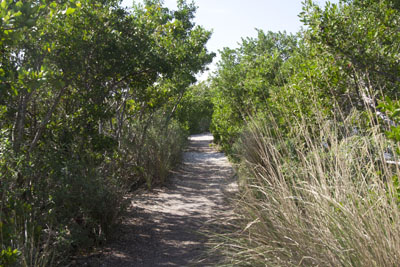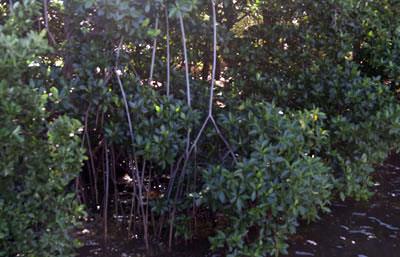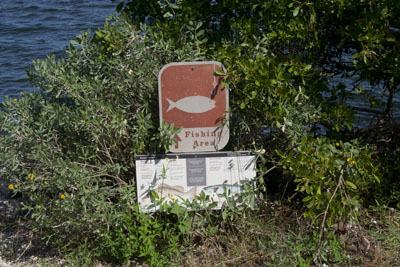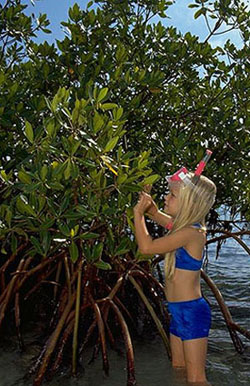
Biscayne Bay mangroves full of diverse life
HOMESTEAD, Fla. — There are four major ecosystems found at Biscayne National Park: mangrove forests, Biscayne Bay, the Florida Keys and coral reefs.
By protecting these ecosystems, the park has become a haven for animal life.
The mangroves have the important job of protecting the animals as well as the shoreline. The roots of the mangroves keep the waters clean and clear and protect the shore from eroding.
| Click on the video at the left to view an audio slide show narrated by Biscayne National Park Ranger Elizabeth Edwards and photographed and produced by writer Olivia Woolbright. |
“The roots are like a fortress…a hiding place,” Gary Bremen, a Park Ranger at Biscayne National Park, stated.
They provide shelter and protection for a host of marine life. The trees’ branches provide breeding and nesting for birds.
Many endangered species whose habitats were destroyed by human activity take refuge here.
If you take a walk down the quarter-mile trail built along the western edge of the park, you will be able to view the different kinds of mangroves. These are one of the longest stretches of forests left on the East Coast of Florida.
By definition, mangroves are several trees that are not related and have the ability to thrive in salty environments. Some block the absorption of salt at their roots and others secret excess salt through their leaves. These mangroves line the parks shoreline as well as the islands.
“I would like to think of them as the pacifists; they do not like to fight for fresh water. So, they have adapted to life in the salt water,” Elizabeth Edwards, a Biscayne National Park Interpretive Ranger, stated.
| At right, a mangrove lined trail for visitors to explore extends into Biscayne Bay (Photos by Olivia Woolbright). Below, red mangroves, which are home to numerous marine organisms. |  |
The mangroves are the foundation of the marine life food chain.
“The leaves falling is the critical first step of the food chain,” Bremen stated.
Once the leaves fall they become food for shrimp, crabs, and worms. Small fish feed on these creatures and they in turn are eaten by larger fish like the mangrove snapper.
Finally, the larger fish become food for wading birds, crocodiles and birds of prey such as eagles or ospreys and even humans.
The leaves that fall from the mangrove branches break down to become food for these organisms all year round.
 These organisms become food for larger animals including different species of fish, pink shrimp and the Florida spiny lobster.
These organisms become food for larger animals including different species of fish, pink shrimp and the Florida spiny lobster.
The mangrove forests must maintain their health in order to preserve Florida’s vital recreational and commercial fisheries. The mangroves are divided into three kinds: red, black and white.
Following the trail, what you stumble upon first are the red mangroves.
Red mangroves, which got their name because of the color of their bark, thrive along muddy coastlines. Its roots face down and reach out toward the water and spread out as deep as three feet. These roots grow in thickets and therefore, are impenetrable. Many of these red mangroves were destroyed to gain access to the shore and the water used for condos, hotels and manmade beaches.
Now, more mangroves receive protection throughout the state and on private property. The seeds drop into the water for up to a year, make their way to the shore and later begin to grow into new trees.
“All juvenile marine life starts off in the red mangroves,” Edwards stated. The shallow waters make it easy for small organisms to have a hiding place from predators.
The black mangroves appear next on the trail. Black mangroves thrive in mostly salty, saturated soil along tidal shorelines. Compared to the red mangroves, the black prefer higher and dryer soils.
The cigar-like “pneumatophores” sticking out of the soil around the trunk characterize the black mangroves. These roots can extend six or more inches above the soil, giving the roots oxygen on the surface as the tide comes in. Like the red mangrove, the black mangrove’s seeds will germinate while still on the tree and can float in saltwater for up to four months before finding a suitable place to grow.
 |
At left, Biscayne National Park designates certain spaces for visitor fishing in the mangroves. Below, a young visitor prepares for some shallow water snorkeling in the park. |
Finally, closer to the end of the trail comes the white mangroves. The white mangrove is normally found further inland than the red or black mangroves. The base of its leaves have two salt-excreting glands near the leaf blade which allow it to get rid of excess salt.
All of the mangroves have trouble with cold weather and freezing, but the white mangrove is the least cold tolerant of the three. Ants eat the sweetness expelled from the leaves along with other insects that may prey on the white mangroves.
The best way to explore the mangroves is by canoe. You can also kayak through the waters or snorkel to get a better view of the marine life.
Many park visitors spend a great amount of time fishing in the waters surrounding the mangroves. Regulations have been enforced that restrict the size and amount of fish people are allowed to catch.
Jah Carter, resident of nearby Perrine, Fla. fishes here every week.
“It’s beautiful. I really try my best to follow the fishing restrictions in order to keep the fish from becoming extinct,” Carter stated.
 Mangrove snapper must be at least 10 inches long to keep. Following fishing regulations will ensure healthy fisheries in and outside of Biscayne National Park.
Mangrove snapper must be at least 10 inches long to keep. Following fishing regulations will ensure healthy fisheries in and outside of Biscayne National Park.
“The [regulations] ensure that we have enough out there to produce more,” Bremen stated.
If You Go:
The mangroves are located along the shoreline of Biscayne National Park at Convoy Point.
If you go to the Dante Fascell Visitor Center, they are near the picnic area and out on the jetty.
Visitors with canoes or kayaks of their own can launch them for free at the Dante Fascell Visitor Center.
The park’s concessioner rents canoes and kayaks — call 305-230-1100 or visit their website at http://www.BiscayneUnderwater.com for details.
Address:
9700 SW 328 St., Homestead, Fla. 33033.
Directions:
From the North:
From the Florida Turnpike: Take the Florida Turnpike south, to Exit 6 (Speedway Boulevard). Turn left from exit ramp and continue south to S.W. 328th Street (North Canal Drive). Turn left and continue to the end of the road. It is approximately five miles, and the entrance is on the left.
From U.S. 1: Drive south to Homestead. Turn left on SW 328th Street (North Canal Drive), and continue to the end of the road. It is approximately nine miles, and the entrance is on the left.
From the South:
Traveling on U.S. 1 (Overseas Highway), drive north to Homestead. Turn right on SW 328th Street (North Canal Drive — first light after Florida Turnpike entrance), and continue to the end of the road. The entrance is approximately nine miles on the left.

Comments are Closed